It’s a classic mistake: walking into a golf shop and grabbing the same sleek-looking irons you saw a tour pro using last Sunday. But here's a hard truth—choosing the right golf clubs has very little to do with chasing what the pros use and everything to do with matching the equipment to your swing.
The best set for you hinges entirely on your current skill level, swing speed, and what you’re willing to spend. Forgiving, game-improvement clubs will help a new player find consistency and fun, while a pro’s blade irons would just cause frustration.
Matching Clubs to Your Current Skill Level
Before you even think about brands or prices, the most important step is an honest self-assessment. Where is your game right now?
Are you a brand-new golfer still trying to break 100? A casual weekend player who shoots in the 80s or 90s? Or a dedicated player grinding to get that handicap down into the single digits?
This initial reality check guides every other choice you'll make. It’s not about ego or where you want your game to be next year. It’s about buying the right tools for the job today.
Think of it this way: a tour pro’s clubs, often called "blades" or "players' irons," have a tiny sweet spot and offer almost zero forgiveness on mishits. For an amateur, playing with them is like trying to learn to drive in a Formula 1 car. It's not just difficult; it's a surefire way to develop bad habits out of sheer frustration.
Why Your Handicap Dictates Your Gear
Game-improvement clubs aren't a compromise; they're engineered specifically for the vast majority of golfers. They’re packed with technology designed to help you, not challenge you. These clubs usually include features like:
- Larger Clubfaces: A bigger sweet spot means your off-center hits still fly straighter and almost as far as your good ones.
- Perimeter Weighting: Weight is moved to the edges of the clubhead, making the club more stable at impact and preventing it from twisting on mishits.
- Wider Soles: The bottom of the club is thicker, helping it glide through the grass instead of digging into the turf—a real lifesaver on those "fat" shots.
This focus on forgiving technology is a massive force in the golf industry. The global golf club market is expected to grow from US$ 4.37 billion in 2025 to US$ 5.45 billion by 2032, and a huge part of that growth comes from manufacturers creating smarter, more accessible clubs for everyday players. You can discover more insights about the growing golf club market and its trends.
Choosing clubs above your skill level is one of the fastest ways to get frustrated and stop enjoying the game. Your goal is to find equipment that makes golf easier and more fun, allowing your skills to develop naturally.
To give you a starting point, here is a quick reference table that connects golfer profiles with the kind of club technology that will help them most.
Golfer Profile and Key Club Features
| Golfer Profile | Typical Handicap | Primary Goal | Key Club Features to Look For |
|---|---|---|---|
| Beginner | 20+ | Consistency & Forgiveness | Oversized clubheads, wide soles, significant offset, perimeter weighting |
| Mid-Handicapper | 10-20 | Blend of Forgiveness & Feel | Mid-sized clubheads, moderate sole width, some workability, cavity back design |
| Low-Handicapper | Below 10 | Precision & Control | Compact clubheads, thin toplines, minimal offset, forged construction |
Ultimately, your handicap is your roadmap.
High-handicap players (20+) will see the biggest benefit from super game-improvement sets. Mid-handicappers (10-20) can look at game-improvement irons that offer a better blend of feel and control. Low-handicap players (below 10) have the skill to handle players' irons that reward precision and allow for advanced shot-shaping.
This honest evaluation isn’t just a suggestion—it’s the foundation of a smart purchase.
Building Your First Golf Club Set
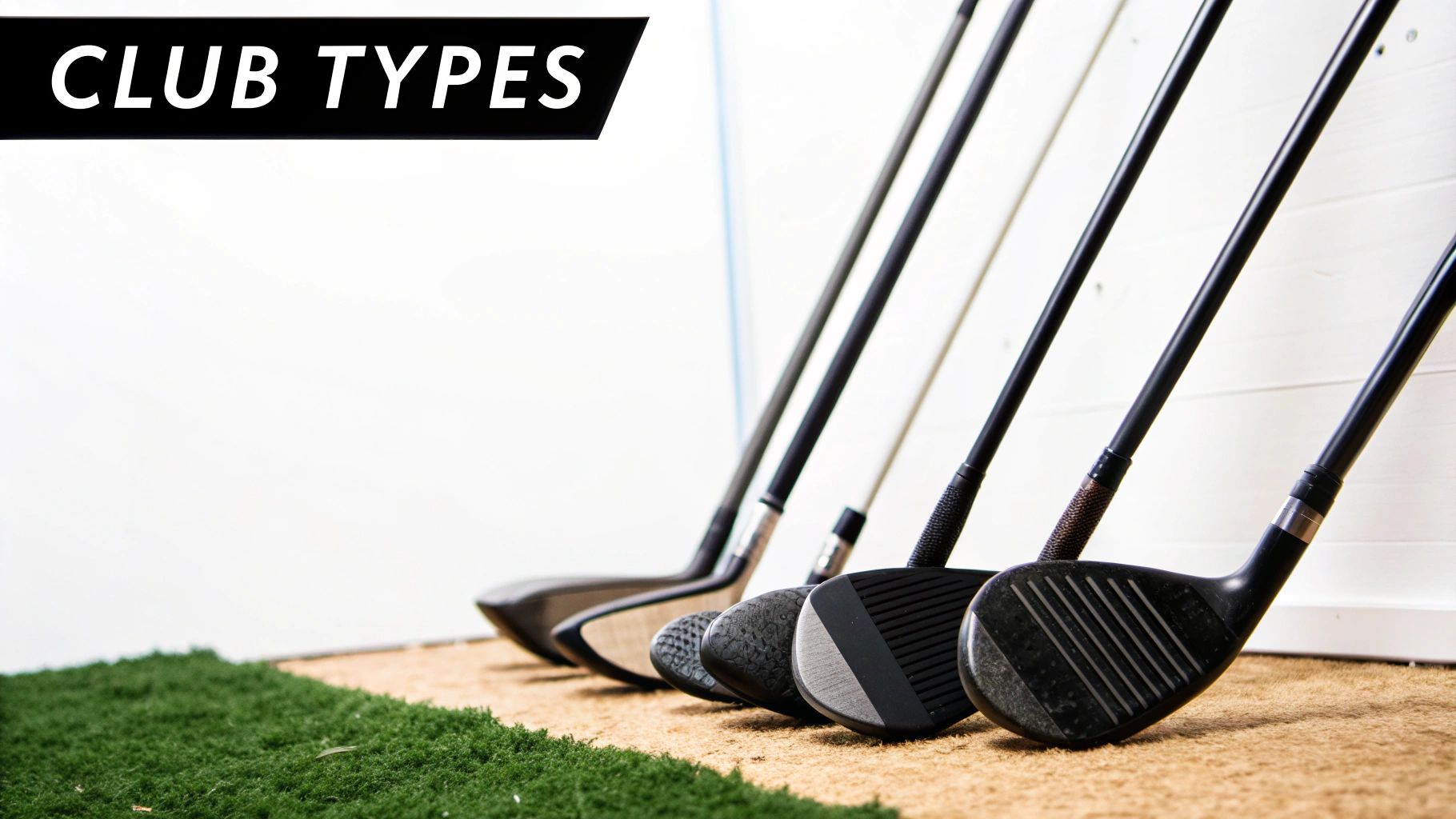
Walking into a golf store for the first time can be pretty intimidating. You're hit with rows upon rows of gleaming, expensive-looking clubs, and it's easy to think you need one of everything.
While a full bag legally holds 14 clubs, here's the good news: you absolutely do not need a complete set to get started. In fact, thinking you need every club right away is one of the most common mistakes new golfers make. A smaller, more manageable set helps you master the fundamentals without the mental clutter of too many choices.
The Essential Clubs for a Starter Set
Your goal should be to assemble a functional "half-set" that covers all the basic shots you'll face on the course. This approach lets you learn each club's purpose and build confidence without feeling overwhelmed.
Here’s a practical roadmap for the clubs you should prioritize:
- Driver: This is the big dog, the longest club in your bag. It’s designed to hit the ball as far as possible off the tee on Par 4s and Par 5s. Look for one with a large head (460cc) and a higher loft (10.5 degrees or more) to maximize forgiveness.
- A Hybrid: Honestly, hybrids are a beginner's best friend. They are built to be much easier to hit than long irons (like a 3, 4, or 5-iron) but still give you great distance and a high, soft-landing launch. A 4 or 5-hybrid is the perfect starting point.
- A Few Key Irons: You don't need the whole 3-through-9 sequence. A 6-iron, 8-iron, and a Pitching Wedge (PW) will cover your mid-range and short approach shots into the green.
- Putter: This is the club you'll use on every single hole, making it arguably the most important one. Finding a putter that feels comfortable in your hands and suits your natural stroke is crucial for finishing strong.
This core group of just 5-7 clubs is more than enough to play a full round of golf and learn the game properly.
Why Hybrids Are a Game Changer
The modern hybrid club has become a secret weapon for amateur golfers, and for good reason. For decades, long irons were notoriously difficult for the average player to hit well. They have tiny sweet spots and demand a precise, downward strike to get the ball airborne.
Hybrids solve this problem by combining the easy-to-hit design of a fairway wood with the accuracy of an iron. Their wider sole helps the club glide through the turf instead of digging, making it much easier to get the ball up in the air, even on swings that aren't perfect.
By swapping out hard-to-hit long irons for user-friendly hybrids, you instantly make the game more enjoyable and can shave strokes off your score on longer holes.
Statistically, understanding which clubs form the backbone of a set is key. Market research shows that irons and drivers consistently dominate sales, as they are central to a player's power and versatility. You can read the full research about golf club market segments to see how buying patterns reflect what's needed on the course.
As you build your set, also think about how each choice makes the game physically easier, which is especially important for preserving energy over 18 holes. For example, our guide on how electric push carts as a game changer for senior golfers dives into how the right equipment can significantly reduce fatigue.
Understanding Shafts and Club Specs
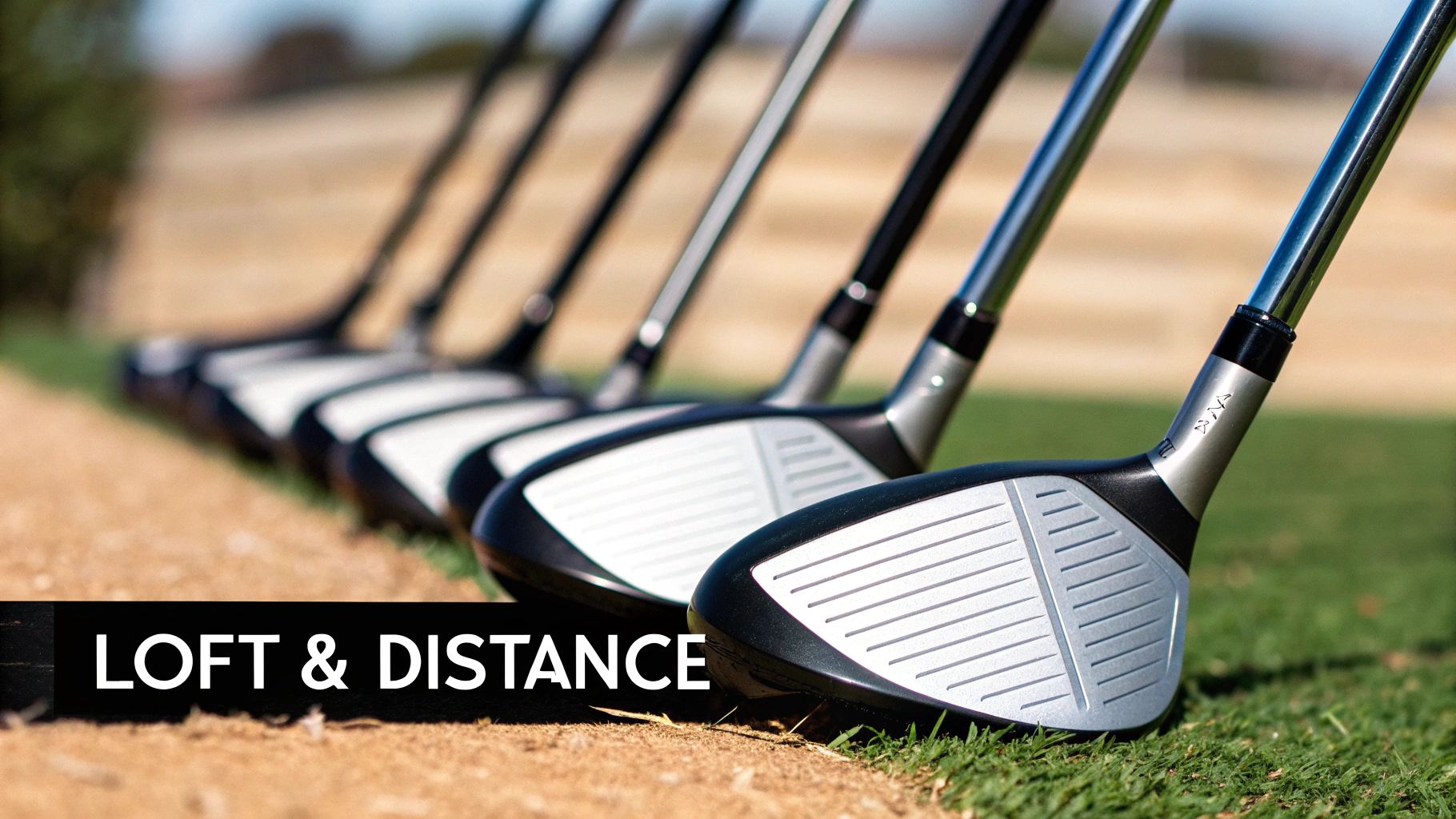
While the flashy clubhead always seems to steal the show, the real engine of your golf club is the shaft. I like to think of it as the transmission in a car—it’s responsible for transferring all the energy from your swing directly into the ball. Getting this piece of the puzzle right is absolutely crucial for your timing, feel, and overall consistency.
The two main materials you're going to run into are steel and graphite. They each serve a very different type of player, and picking the right one is a huge step in learning how to choose golf clubs that truly fit your game.
Steel vs. Graphite: The Material Question
Steel shafts are the old-school workhorses. They're heavier, more durable, and offer a much stiffer feel that gives you exceptional feedback and control. This is exactly why players with faster swing speeds almost always gravitate toward steel, especially in their irons. It helps them manage their power and hit those precise, controlled shots that find the green.
Graphite shafts, on the other hand, are significantly lighter. That drop in weight lets a player swing the club faster, which translates directly into more clubhead speed and, you guessed it, more distance. It's why graphite is the standard for drivers and fairway woods. It’s also an excellent choice for beginners, seniors, or any player with a moderate to slow swing speed who could use a little help generating more yardage.
The right shaft material isn't about which is "better," but which is better for your swing. A faster swinger gains control from steel, while a slower swinger gains much-needed speed from graphite.
Decoding Shaft Flex
Shaft flex is simply a measure of how much a shaft bends during your swing. Matching your flex to your swing speed is one of the most important parts of getting properly fit for clubs. When the flex is wrong, you'll find yourself making weird, unnatural compensations in your swing, which is a recipe for inconsistent shots.
You'll generally see a few main categories:
- Stiff (S) or Extra Stiff (X): This is for players with very fast swing speeds. They need maximum control to keep the ball from ballooning high into the air or hooking hard to the left (for a righty).
- Regular (R): This is the most common flex out there, and it’s a great fit for the average male golfer with a moderate swing speed.
- Senior (A or M) and Ladies (L): These shafts are much more flexible. They're designed for players with slower swing speeds, helping them launch the ball higher and squeeze out every last yard of distance.
A simple way to get a ballpark idea of where you stand is to look at your driver distance. If you typically hit your driver around 230-250 yards, a Regular flex is probably a good starting point. Hitting it consistently over 250 yards? You should definitely be looking at a Stiff flex. On the flip side, if your drives are usually under 210 yards, a Senior or Ladies flex will give you the launch assistance you need. Getting this spec right is the key to unlocking true consistency on the course.
Is a Custom Club Fitting Worth It?
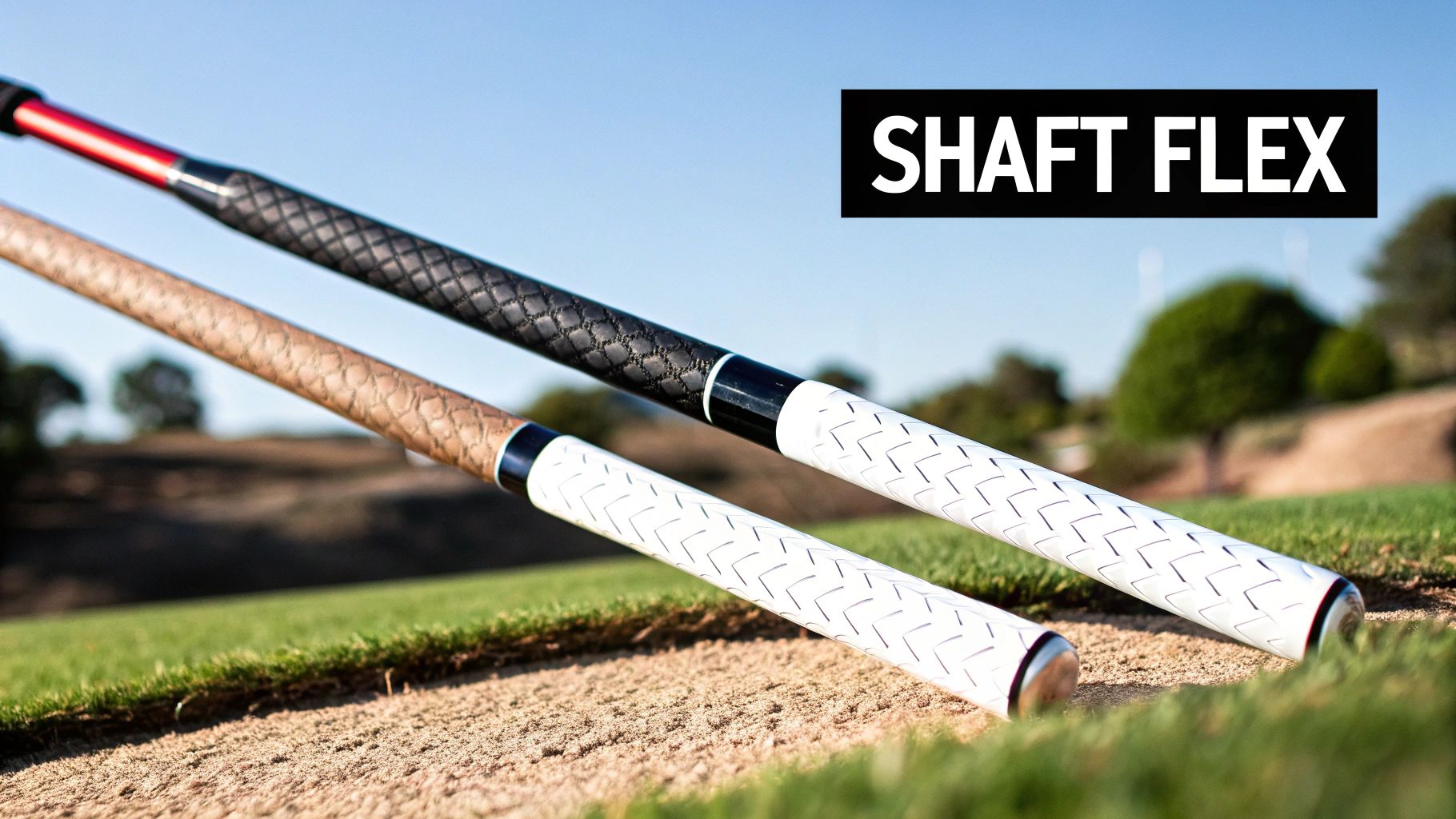
So many golfers, particularly those with a higher handicap, write off a custom club fitting as a luxury for scratch players and pros. Honestly, that’s one of the biggest myths in golf. The reality is that a fitting is even more valuable for the average player whose swing isn't perfectly consistent.
Think about it: a tour pro can adapt their swing to just about any club and still hit a great shot. An amateur, on the other hand, might spend years fighting against ill-fitting equipment, grooving bad habits without ever realizing the clubs are the problem. A proper fitting isn't just about buying shiny new gear; it’s one of the best investments you can make in your own game.
What Really Happens During a Fitting
A modern club fitting is a whole lot more than just measuring your height. It's a deep dive into your swing's DNA, driven by hard data. A certified fitter will have you hit shots into a simulator that uses a launch monitor to track dozens of data points about your swing and ball flight.
This isn't guesswork. It's an objective look at what's actually happening at impact. Key metrics the fitter will be watching include:
- Swing Speed: This is the first clue to finding the right shaft material and flex to transfer your power efficiently.
- Ball Speed: This shows how well the club is sending energy into the ball. Higher is better!
- Launch Angle: The angle your ball takes off. Too low and you lose carry distance; too high and it balloons and falls out of the sky.
- Spin Rate: This is critical for maximizing driver distance and creating enough stopping power with your irons to hold the green.
With this data, the fitter can pinpoint the exact club specs that will complement your natural swing, not fight against it.
Dialing in the Crucial Specs
The launch monitor data is the diagnostic tool, but the real magic happens when the fitter starts tweaking the clubs to improve those numbers. They can swap out different heads and shafts on the spot, letting you see and feel the difference immediately.
For instance, let's say you're constantly fading the ball to the right. You might blame your swing, but the data could reveal the problem is an incorrect lie angle—the angle between the shaft and the sole of the club. If it's too flat for you, the clubface will point right at impact, causing that slice. A simple adjustment to make the lie angle more upright can straighten out your ball flight in a matter of minutes.
A custom fitting is the fastest way to buy a better game. It stops you from guessing what might work and instead uses concrete data to build a set of clubs that are an extension of your body and swing.
The True Cost and Benefit Analysis
The cost for a professional fitting can run anywhere from $50 to $150 per hour, depending on the facility and what you’re getting fitted for (a single club vs. a full bag). Here's the kicker: many shops will waive the fitting fee entirely if you buy the clubs from them, which makes it a no-brainer.
The benefits show up right away and stick with you for the long haul. Getting specs like club length, lie angle, shaft flex, and grip size right from the get-go can fix flaws you’ve been battling for years. It ensures that every time you head to the range, you're practicing with equipment that's actually built to help you succeed. For anyone serious about choosing the right golf clubs, a fitting removes all the guesswork.
Shopping Smart for New and Used Clubs
Once you’ve got a handle on the club specs you need, it's time to dive into the market. This is where a big question comes up for a lot of golfers: should you invest in a brand-new set or hunt for a great deal on something pre-owned?
Honestly, there’s no single right answer here. The best path for you really boils down to your budget and what you’re looking for.
The Case for Buying New
Buying new clubs has an undeniable appeal. You’re getting the latest and greatest in golf technology, a full manufacturer's warranty, and the pure satisfaction of knowing you’re the very first person to swing them. For a lot of golfers, that peace of mind is worth the premium price tag.
You get clubs with perfect, untouched grooves and the exact specifications you were fitted for, right out of the box.
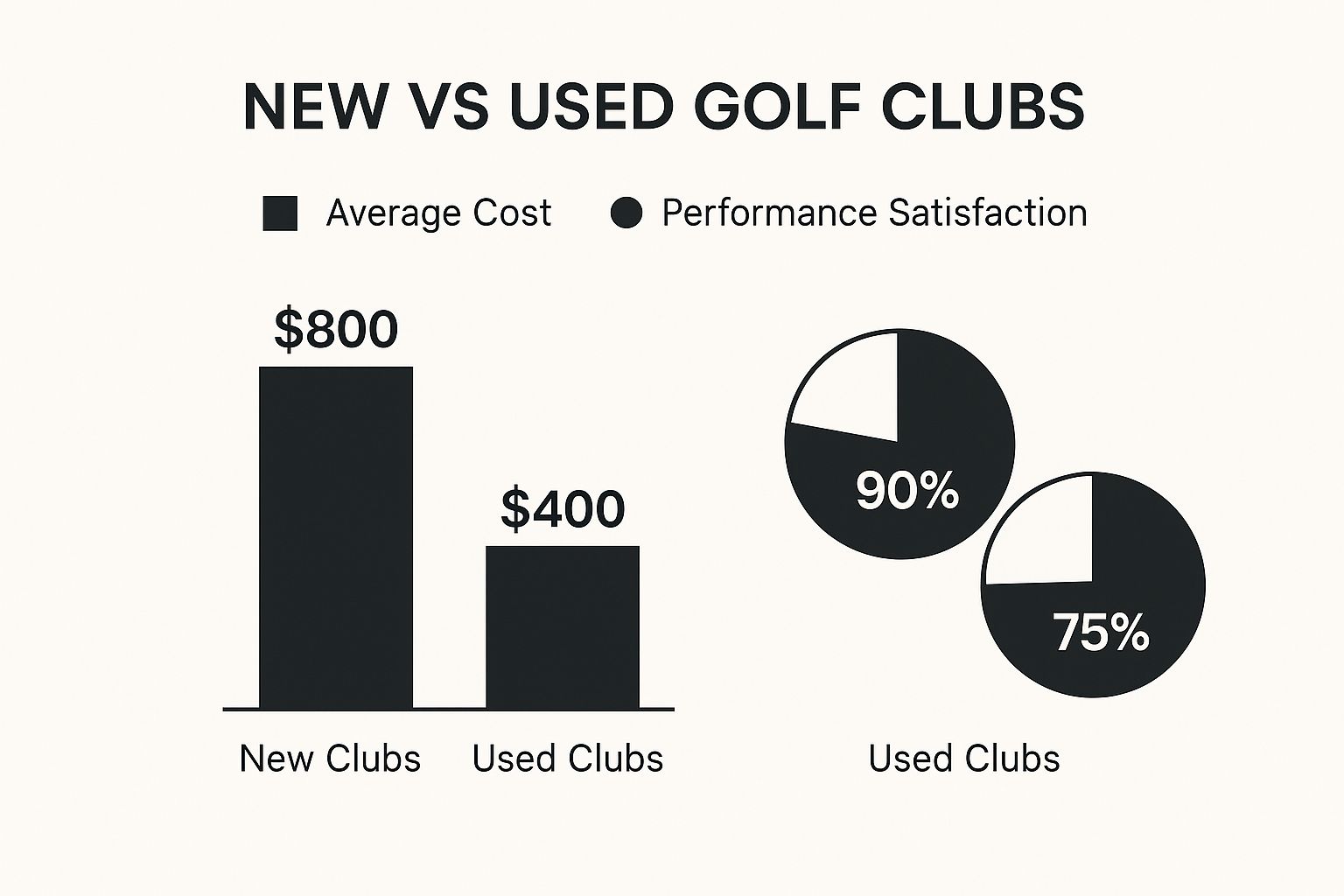
As you can see, new clubs tend to lead to higher satisfaction, but you can’t ignore the huge savings that come with used clubs. They're an absolutely fantastic way to get into the game or upgrade without breaking the bank.
Finding Value in the Used Market
The used club market is where you can find incredible value, letting you get your hands on high-quality equipment from top brands at a fraction of the original price. But it does require you to be a bit more of a detective.
When you’re looking at pre-owned clubs, you need to inspect them carefully. Pay close attention to these key areas:
- Grooves: Check the grooves on the clubface, especially on irons and wedges. If they look really worn down, that club is going to have a tough time generating the spin you need for control.
- Shafts: Look for any signs of rust on steel shafts or splintering on graphite ones. It’s also a good idea to make sure the shaft band is original—a club with a mismatched shaft might have been poorly re-shafted.
- Grips: While grips are easy enough to replace, worn-out, slick grips will need to be changed right away. Factor that into your cost, as it'll run you about $10-$15 per club.
To help you decide, here's a practical comparison of what to expect from new versus pre-owned equipment.
New vs Used Golf Clubs: Deciding What's Best for You
| Factor | New Golf Clubs | Used Golf Clubs |
|---|---|---|
| Cost | Higher initial investment. | Significantly lower price, offering great value. |
| Technology | Features the latest innovations and designs. | Often 1-3 generations behind the current tech. |
| Condition | Pristine and unused. | Varies from "like new" to heavily used. |
| Warranty | Comes with a full manufacturer’s warranty. | Typically no warranty, sold "as is." |
| Customization | Can be custom-fitted to your exact specs. | Limited to what's available; modifications cost extra. |
| Peace of Mind | Confidence in the club's history and quality. | Requires careful inspection for hidden damage. |
Ultimately, whether you go new or used depends on how you weigh these factors. If you’re a beginner or on a tight budget, the used market is an amazing resource. If you’re a competitive player looking for every possible advantage, new might be the way to go.
This buying decision is also influenced by wider economic patterns. Historical analysis shows that the golf club market has remained resilient, with buyer behavior shifting based on disposable income and industry promotions. You can learn more about golf club market findings to see how global trends might affect your purchase.
Your shopping experience matters, too. Big-box stores have simulators where you can test clubs, which is a huge plus. Your local pro shop, on the other hand, provides expert, personalized advice. Online retailers often have the best prices but you lose that hands-on feel.
And no matter where you get your clubs, you’ll need a good way to get them around the course. For golfers who prefer to walk, our guide on how to choose a golf push cart can help you find the perfect ride for your new (or new-to-you) set.
Common Questions About Choosing Golf Clubs
Even after you've done all the research, a few questions always seem to pop up right before you pull the trigger on a new set. This is the final hurdle in learning how to choose golf clubs—clearing up those last few doubts so you can buy with total confidence.
Let's walk through the most common questions golfers have when they’re standing at this crossroads.
How Much Should a Beginner Spend on Their First Set?
You absolutely do not need to empty your wallet to get started in golf. A complete beginner's package, often called a "box set," from a reputable brand is a fantastic entry point. These typically run between $300 to $600 and come with everything you need to head straight to the course.
These sets are engineered for maximum forgiveness, which is exactly what new players need to build confidence and, most importantly, have fun. A high-quality used set is another great option in that same price range. The goal is simple: get forgiving clubs, not necessarily the newest or priciest ones.
How Often Should I Replace My Golf Clubs?
There's no magic expiration date stamped on your clubs. For the average golfer, a quality set can easily last 5-10 years. More often than not, you'll find yourself upgrading because technology has genuinely advanced—offering real benefits like more distance or forgiveness—not because your old clubs have worn out.
A good time to start looking is when you feel like your skills have clearly outgrown what your current set offers, or when a new technology directly solves a persistent weak spot in your game.
The best reason to upgrade your clubs is when new equipment solves a problem your old equipment can't. Don't just chase the latest model; look for technology that serves a purpose for your specific game.
Can I Mix and Match Different Brands in My Set?
Absolutely, and you shouldn't hesitate to do so. It’s extremely common for golfers at all levels, including the pros on tour, to carry a bag with multiple brands. There are no rules against it. The only thing that matters is that each of the 14 clubs in your bag performs perfectly for your swing.
You might find you love the feel of one brand's driver, another's irons, and a third's putter. A custom fitting is the ideal place to build this kind of ultimate mixed set, as the fitter’s only goal is to find the best-performing club for each slot, regardless of the logo on it.
Are Expensive Golf Clubs Actually Better?
More expensive clubs often use premium materials and feature the very latest design innovations. For highly skilled players, these can provide small but meaningful performance gains. For beginners and mid-handicappers, however, "better" almost always means "more forgiving."
An expensive set of blade irons designed for a low-handicap player will likely be much harder to hit, turning the game into an exercise in frustration. Your focus should always be on finding clubs that match your current ability level, not the price tag. While you're thinking about gear, don't forget accessories that make your round more enjoyable, like the ones covered in our guide to the 5 best golf push carts.
At Caddie Wheel, we believe in making every round of golf more enjoyable. Our electric power assist wheel turns your standard push cart into a motorized caddy, letting you walk the course without the strain. Conserve your energy for the next shot and experience the freedom of an effortless round. Upgrade your push cart with Caddie Wheel today.

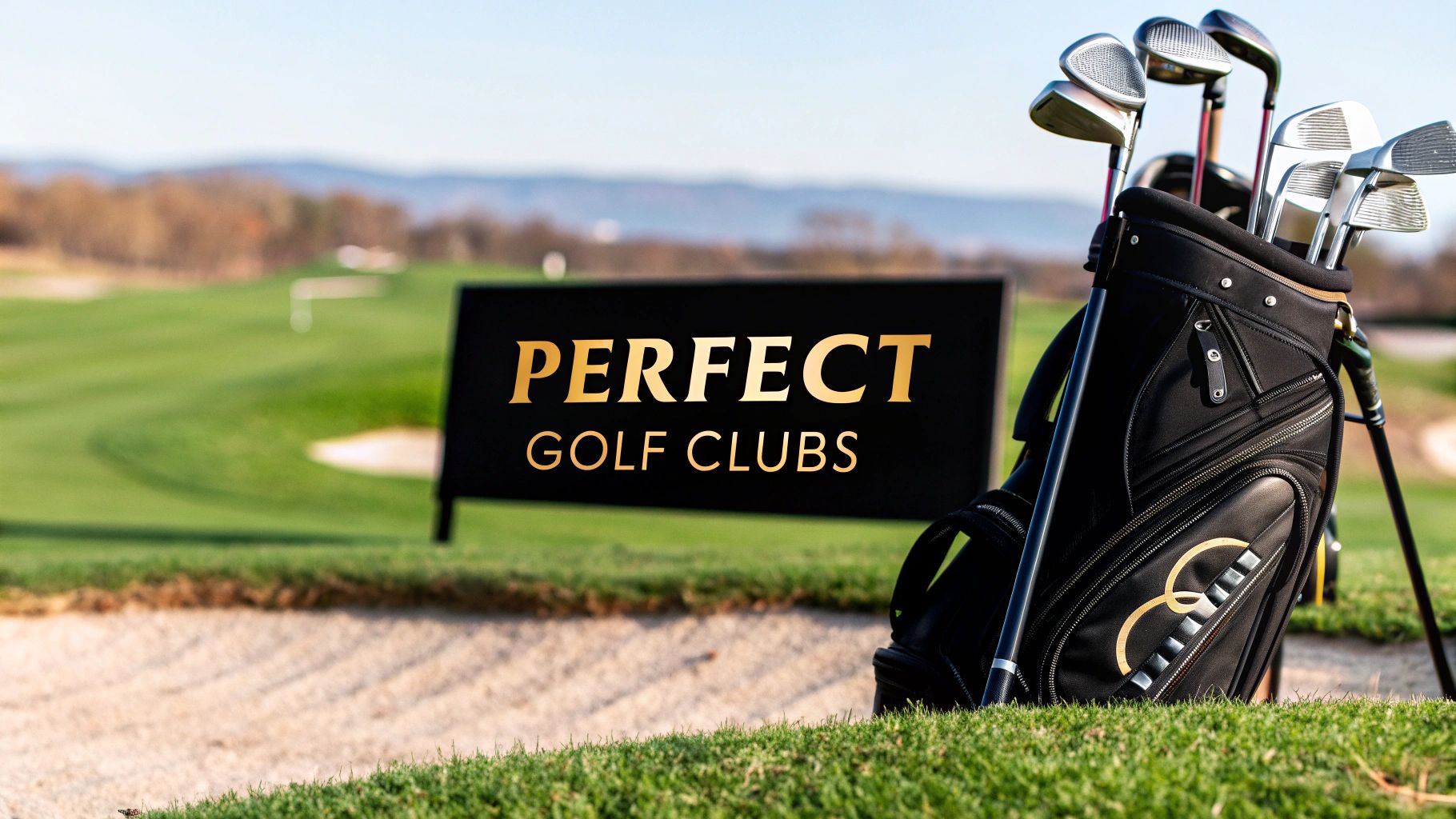
Share:
Effective Golf Course Management Strategies to Boost Your Club
Boosting Your Electric Golf Cart Range